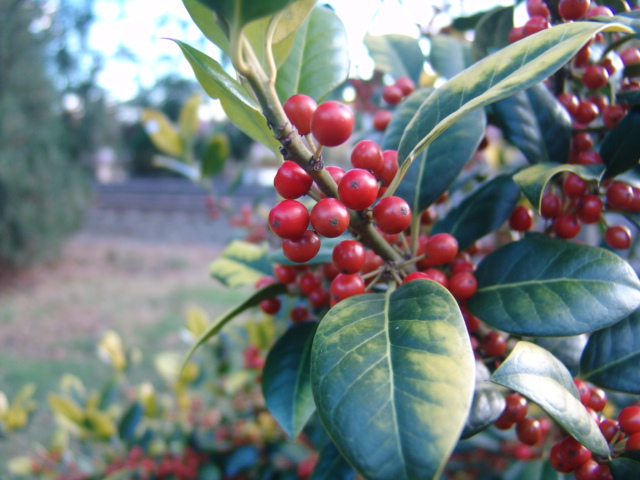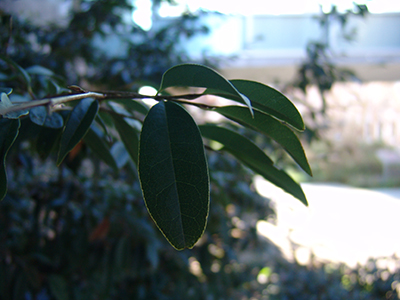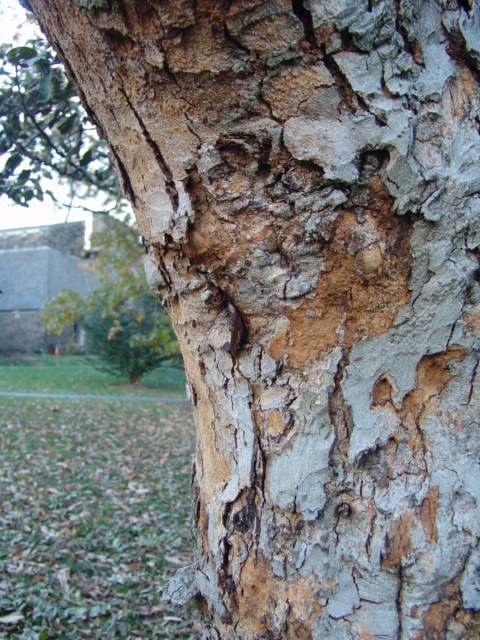
Plant of the Week: November 20

Ilex ‘Whoa Nellie’
A brief and sudden cold-snap has decimated much of the tender greenery on Swarthmore’s campus. Thus, I’ve been looking for any bright pops of color to cheer me up before winter really sets in. Tucked away on the south side of the Cotswold Frats close to the train tracks is a small specimen of the Ilex cultivar ‘Whoa Nellie’. This cultivar was named by Tony Avent of Plant Delights Nursery in honor of the (I.cornuta x I. aquifolium) hybrid ‘Nellie R. Stevens’ from which the sport was cut. ‘Whoa Nellie’ boasts a consistent new-foliage variegation of strong, uniform, yellow leaves that fade to deep green with maturity, giving the plant a bright halo effect that draws attention from afar. The cultivar is female and sets orange-red berries when planted in proximity to male Ilex cornuta or the male hybrid Ilex ‘Edward J. Stevens’. Photo credit: J. Bickel

Sycopsis sinensis
I always appreciate it when I happen upon an overlooked oddity. Having passed this shrub in the entrance to the Pollinator Garden possibly hundreds of times, I finally noticed it growing proudly in a semi-shady spot. The common name “Chinese fighazel” highlights many aspects of the etymology of the plant’s Latin name, the genus name comes from the Greek roots sykon and -opsis translating literally to “fig-like.” It has also been recognized as a member of the witchhazel family Hamamelidaceae, thus “hazel.” The species name literally translated means “Chinese.” The flowers are very similar to those of the genus Parrotia and the two plants have even been hybridized to create a rare intergeneric hybrid xSycoparrotia semidecidua. Sycopsis sinensis blooms very early, in our area it opens in February and March with the witchhazels. Photo credit: J. Bickel

Carya illinoinensis ‘Busseronne’
Carya illinoinensis is a remarkably important agricultural tree; it is the source of the edible pecan. A member of the walnut family Juglandaceae, C. illinoinensis produces a heavy load of thick-husked, hickory-nut resembling fruits which are squirrels’ fall favorites. Though past its time of fruit setting and currently dropping its leaves, I was drawn to the interesting, spotty slough pattern of the bark, which I never noticed before. Not peeling in long strips as the shagbark hickory, but rather in rounded shapes making for an interesting, randomized topography of color and depth. This tree is considered to be the largest of all of the Carya species. The genus name comes from the Greek myth of the Laconian king Dion’s daughter Carya being turned into a walnut tree by the god Dionysus. The species name refers to the state of Illinois. I was unable to delineate the history of the cultivar, from what I can gather ‘Busseronne’ is the Danish version of the French word “Bourgeron” meaning “work shirt” or “smock.” A stately specimen of this can be found growing near the south side of Sharples Dining Hall. Photo credit: J. Bickel





No Comments